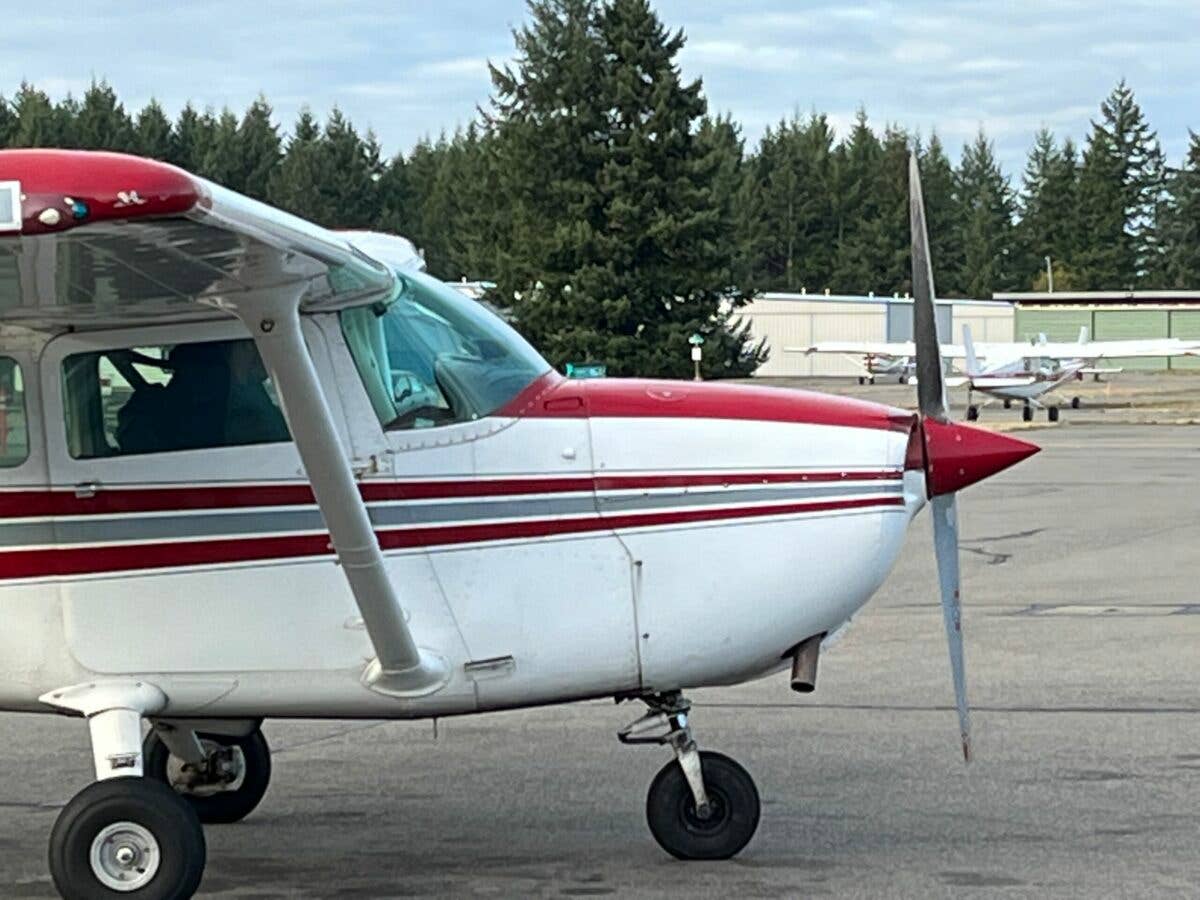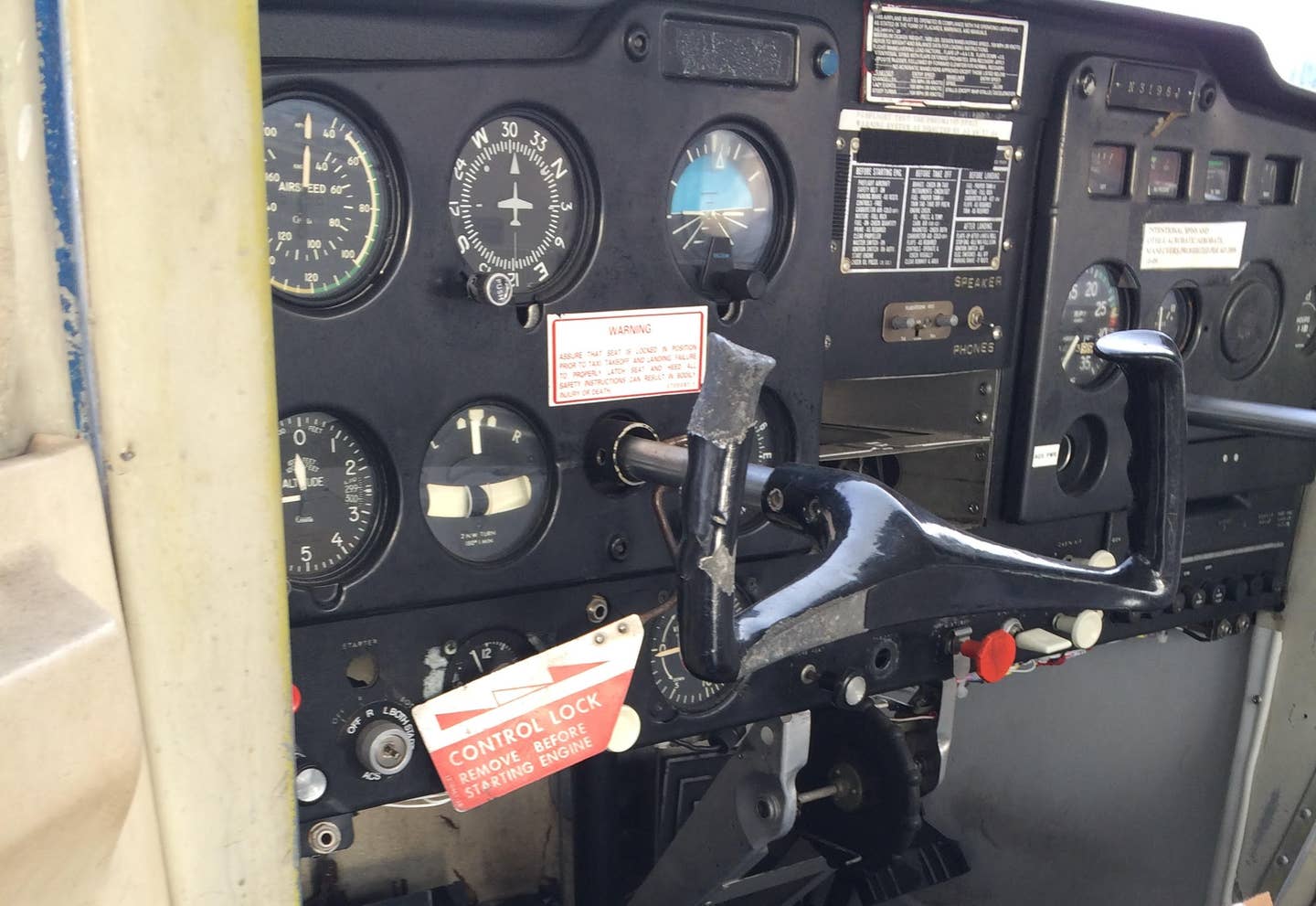Respect the Prop
The situational awareness you are developing as a pilot begins before engine start.

Respect the propeller like it is a bull, or a large dog you do not know. [Credit: Meg Godlewski]
There are many misconceptions about prop wash. There is the classic hazing of a new pilot, asking him or her to get a bucket of it—and then in all seriousness, there are warnings to be mindful of it. Prop wash, the wind coming off the propeller toward the back of the aircraft, does more than mess up your hair and blow your cap off—it can cause a lot of damage to both persons and property, and therefore it must be respected.
Prop wash is a ground thing. It is a hazard right up there with running over a chock or tiedown rope. I have been flying since the Reagan administration. In July, I will mark 20 years as a CFI, and I will tell you that with the exception of a midair collision, accidents caused by sloppy ground handling are what I fear the most. Often these are caused by poor training and a lack of attention by the pilot—or a combination of both. Airplanes are awkward on the ground: You have to watch your wings, your tail, your prop—and your prop wash.
Start on the Ground
The situational awareness you are developing as a pilot begins before engine start. You clear the area in front and to the side of the airplane before you start the engine—and yell “Clear prop!” to let people know what you're about to do—but do you double-check the area behind you? Please say you do.
An acquaintance who is a designated pilot examiner recently told me a story of a check ride when the applicant prepared to start his airplane that was arranged tail to tail with another in the school's fleet. The aircraft were perhaps 10 feet apart, yet the applicant had no issue starting the Cessna 172 and blasting the snot out of the airplane behind it—the DPE had offered to help him pull his airplane out of his parking space and reposition it, but the applicant demurred, saying this was how they always did it.
I question this practice. The minute the propeller starts turning, that prop wash is a force to be reckoned with. Don't have anything behind the tail. That includes a closed hangar.
Some older hangar doors can have rickety track fittings and the prop wash can damage them. Also, there is the chance that someone has reopened the hangar door between the time you moved your airplane out and completed the pre-start checklist.
I saw this first-hand one winter. We had moved the aircraft into the hangar for defrosting. One went out, one came in, and we surrounded it with step ladders and took towels to brush off the slushy ice. Usually the de-icing was done by the learners and the more invested CFIs.
I had my back to the door when a cold blast, a yell of warning, and the sound of an engine start made me turn around. The hangar door had been raised and the learner in the Cessna 172—his CFI by his side—started the engine with the tail pointed toward the open hangar. Unfortunately, another learner, a young woman weighing no more than 115 pounds, was up on a ladder brushing the slush off another 172. She screamed as the prop wash knocked her backwards off the ladder. She would have landed on her back on the cement floor had not the hockey goalie reflexes kicked in. I dove and caught her. Several people witnessed the event. It was dramatic for all involved. A rule was made to pull the aircraft further from the hangar and reposition the tails so that the hangar door—or the interior of the hangar would not be blasted in the future.
Watch for the Aviation Impaired
You have probably heard stories about someone who stepped out of an aircraft and walked into a spinning propeller. Often these instances happen at night. The outcome is never good. There are also people who walk into spinning propellers in the daytime because they don't understand that when the propeller is spinning, it moves so fast it blurs and in essence, disappears. Or they walk in front of a tailwheel-equipped aircraft because they don't realize that the pilot does not have good forward visibility.
Some flight schools and FBOs that conduct introductory or scenic flights and 'hot load' (exchanging passengers with the engine still running) will make sure each person is escorted to the aircraft and instructed well in advance to stay behind the wing or the strut. When departing the aircraft, they are escorted to the rear and away from the nose. Other businesses avoid the issue altogether by prohibiting hot loading, and instead they perform a complete engine shutdown.
You may have noticed how line service people will not approach your aircraft for refueling until you show them that the key is out of the ignition and the magnetos are indeed off. Respect the propeller like it is a bull, or a large dog you do not know.
Danger, Will Robinson
Many airports have locked gates and signs on the ramps that read something to the effect of “No Unescorted Persons On the Ramp” or “Authorized Personnel Only.” There is a reason these signs are all in caps and usually printed in red—the aviation impaired are a hazard on the ramp, because they don't realize the danger to themselves or the airplane.
For example, I was working with a pre-solo learner who was about to start the Cessna 172 for the first time. We had gone through the preflight inspection and pre-start checklist. He yelled "Clear prop!" and just as he was about to start the engine, his father appeared outside the aircraft on the pilot's side. He had his hands on the window and was peering in at his son. I called a warning and stopped the learner from turning the key. There was a quick conversation with the dad—that was a dangerous place to be—did he see the rotating beacon on? That meant we were about to start the engine. Also, there were signs warning that he needed to be escorted on the ramp. Where was his escort?
"I didn't think that applied to me," he replied, adding that he wanted to see what his son was doing, therefore he had every right to be there. With the permission of the chief CFI, the learner invited his father along on a few flights after that. We figured it was better than having Dad wandering up and down the ramp.
One of the most experienced pilots I ever flew with taught me never to have my back to an operating airplane. When an airplane is taxiing by you, turn around so you can make eye contact with the pilot. Stand still, and out of reach of the wings and propeller. The pilot may not know you from Adam's house cat, and he or she doesn't know if you know your way around the ramp or if you're going to do something silly, like walk in front of an approaching aircraft. They will appreciate you letting them pass.
Follow the Lines
Never taxi over anything but recognizable surfaces. Stay on the gold lines—they are supposed to keep you from running over chocks, tie-downs, etc. When you remove the chocks, put them someplace where they won't get in the way of taxiing aircraft. You may even want to curl up the tie-downs and put the chocks on top of them. I have witnessed an operating propeller suck up a tie down strap, cut it in two, and send the steel hook flying. The hook landed a few feet away from me. I kept it as a war trophy and to show my learners what could happen. The airplane, a Mooney, was damaged as well, as the tiedown strap appeared to put some dings in the propeller.
I teach my learners to be extra careful when taxiing near drains especially in low visibility situations, because for a time there the drain grates, heavy metal objects that they were, were being stolen from the airport. I was told the drug culture was attempting to sell them for scrap iron, despite the fact they bore embossed indications of where they came from, and it was obvious they were stolen. Hitting an open drain or a partially open drain with an aircraft tire would quickly ruin your day.
Don't Take Shortcuts
Some pilots at non-towered airports go so far as to announce intentions to taxi—for example, "(insert name of airport traffic) (type of aircraft and location) taxiing to the fuel pumps (name of airport)" and sometimes they find themselves being criticized by other pilots who say it's not necessary and creates unnecessary congestion on the frequency. Perhaps. Perhaps it's also a good idea to have this communication when the ramp is very busy, remembering that you have to listen as well as talk. This helps keep you from being the pilot pulling out from between the rows of hangars who has to slam on the brakes to avoid T-boning the airplane from the local flight school that is taxing past you at high speed because you didn’t make a radio call announcing you were about to taxi to the active from the hangars.
Just like in the air, it just takes one moment of inattention or a foolish choice to damage an airplane, either yours or someone else's, or even airport property. This was drilled home when I watched the chief CFI of a school attempt to pull through a parking spot rather than taxing around it. His airplane ran over a chock and reduced it to kindling. I truly hope learning took place.

Subscribe to Our Newsletter
Get the latest FLYING stories delivered directly to your inbox






